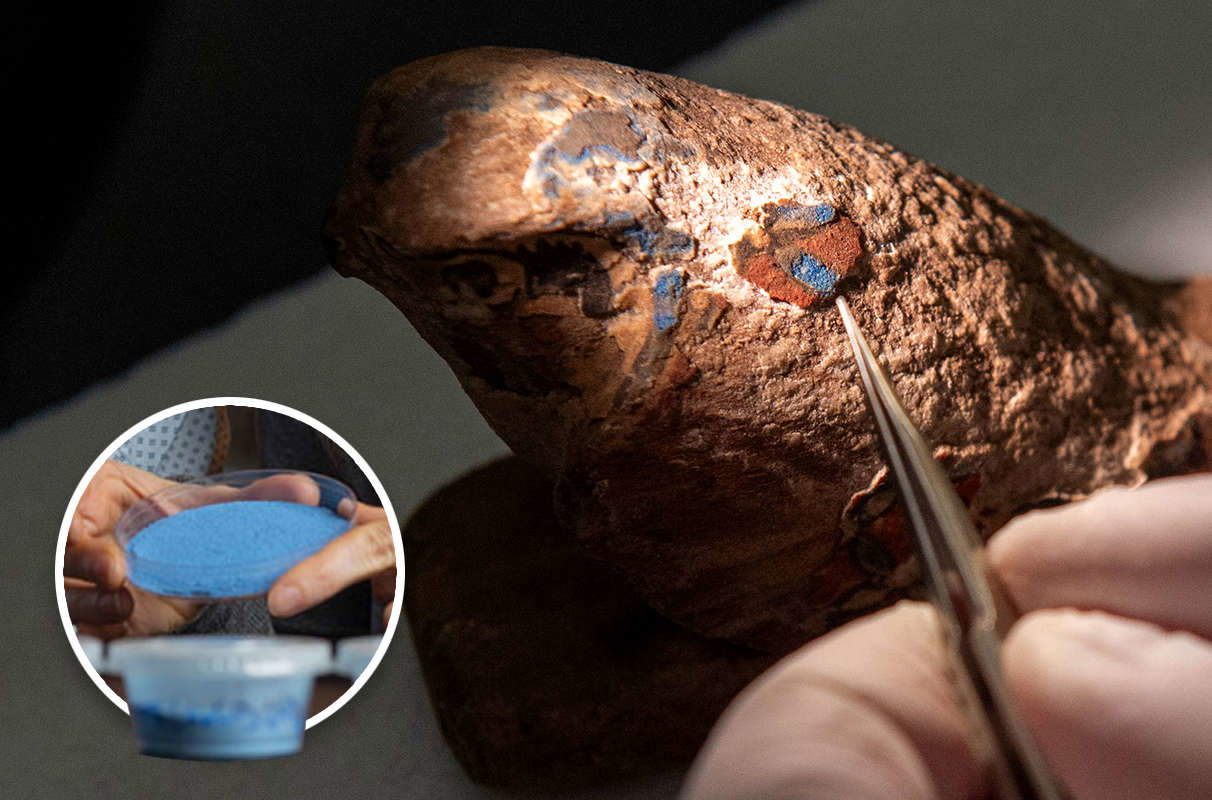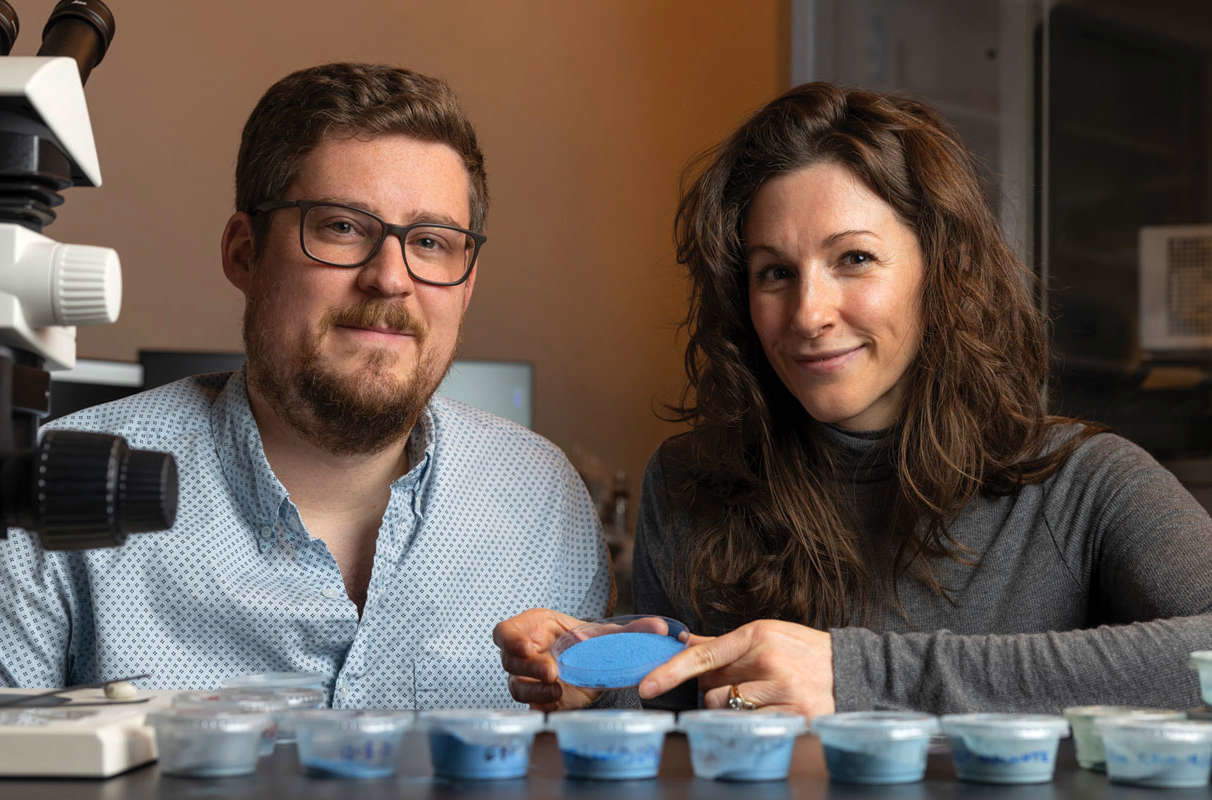For more than five thousand years, mankind has been fascinated by a deep blue capable of spanning the centuries: it is the famous Egyptian Blue, the world’s oldest synthetic pigment, born on the banks of the Nile. A few months ago, an entire ingot of it was discovered in Rome, an extremely rare find whose news has gone around the world. And now Egyptian Blue is featured in a new international study that reveals its color variability and production secrets, so much so that a team of scholars has managed to recreate it in the laboratory. Credit for this achievement goes to John S. McCloy, a professor in the faculty of mechanical and materials engineering at Washington State University, and Edward P. Vicenzi, a researcher at the Smithsonian Institution’s Museum Conservation Institute in Suitland, Maryland, who led the team. The work was done in collaboration with the Carnegie Museum of Natural History in Pittsburgh.
Egyptian Blue is more than just a colored powder. It is the result of a sophisticated alchemy between silica, lime, copper and an alkaline flux, fired at high temperatures in ancient kilns. Its color, a deep, brilliant blue, has decorated statues, frescoes, mosaics and amulets from Pharaonic Egypt to the Roman world and beyond, replacing precious stones such as lapis lazuli and turquoise, which are often too expensive or rare.
But behind its apparent uniformity, EB hides an astonishing variety of hues, from almost black blue to light blue to blue-green or purplish. As early as the fourth century B.C., the Greek philosopher Theophrastus distinguished four color variants, while Pliny the Elder, in the first century A.D., described different qualities and origins. This variability, now as then, is the focus of interest of archaeologists, restorers and materials scientists.

The new study, led by John S. McCloy and colleagues, recreated twelve different “recipes” for Egyptian Blue in the laboratory, varying raw materials and firing times, to investigate how these parameters affect the formation of mineral phases and the final color of the pigment. The analyses were conducted using advanced techniques such as X-ray diffraction, electron microanalysis, and spectroscopy in the visible and near-infrared.
In addition to the synthetic samples, the researchers examined modern commercial pigments, copper doped glass, and, most importantly, two original Egyptian artifacts dated between 2,300 and 3,400 years ago that are housed at the Carnegie Museum of Natural History in Pittsburgh. The same EB samples produced for the study are now on display in the exhibition “Stories We Keep,” which tells the story of how modern science unlocks the hidden secrets of ancient objects.
The chemical star of Egyptian Blue is cuprorivaite (CaCuSi₄O₁₀), a copper-calcium silicate with a corrugated sheet structure where copper ions (Cu²⁺) are coordinated to absorb visible light and return the characteristic blue. But cuprorivaite alone is not enough to explain the chromatic richness of EB.
In fact, the pigment is a heterogeneous material composed of a mixture of crystalline and glassy phases: in addition to cuprorivaite, there are silica glasses doped with copper, wollastonite (CaSiO₃), quartz, and sometimes other minor phases. The proportion between these components, the particle size, and the presence of fluxes such as soda ash (obtained from natron or halophyte plant ash) determine the hue and saturation of the color.

The authors set the firing temperature at 1,000°C, slightly higher than what was considered typical in antiquity (850-950°C), to promote the formation of cuprorivaite even in the absence of fluxes. They then varied the sources of copper (oxide, carbonates such as malachite and azurite, recycled metal or bronze), silica and lime, simulating the possible choices of ancient artisans.
The results show that a percentage of cuprorivaite greater than 50 percent by weight is sufficient to obtain an intense blue, but that the presence of copper doped glass (produced only if the recipe includes soda ash) adds a green component to the dye, as confirmed by spectroscopic analysis. Pigment particle size also affects color perception: finer particles tend to reflect more light, making the blue lighter.
Another crucial factor is the substrate to which the pigment is applied: the white of a canvas, the plaster of a fresco or the stone of a statue can alter the brightness and saturation of the perceived blue. The authors emphasize how this variability must be taken into account in restorations and color reconstructions of ancient works.
Interest in Egyptian Blue is not only archaeological. In recent decades, cuprorivaite has proven to be a material with amazing properties: its crystalline structure allows efficient near-infrared (NIR) light emission, a feature exploited in biomedicine, telecommunications, security inks and lasers. This emission also enables restorers to identify traces of EB even when the visible color has disappeared or been altered by time.
The study’s most innovative contribution is the correlation between synthetic recipes, mineralogical composition and precisely measured color parameters. The authors provide a true “scientific palette” of colors, with practical directions for reproducing the shades observed in ancient finds. This tool will be invaluable to those involved in the restoration, conservation and study of historical materials, allowing them to come ever closer to understanding the technological and artistic choices of past civilizations.
McCloy and colleagues’ study shows that Egyptian Blue is the result of refined materials engineering, capable of modulating color and optical properties through the choice of raw materials, firing conditions and processing. Its history, intertwined with that of glass and glazed ceramics (faience), tells of a widespread and ever-evolving technology capable of adapting to local resources and aesthetic tastes.
Today, thanks to the most advanced analytical techniques, we can not only reconstruct ancient recipes but also draw inspiration from them for new technological applications. The blue of the gods, born on the banks of the Nile, thus continues to illuminate the ric
 |
| A team of scientists has recreated Egyptian Blue, the world's oldest synthetic pigment |
Warning: the translation into English of the original Italian article was created using automatic tools. We undertake to review all articles, but we do not guarantee the total absence of inaccuracies in the translation due to the program. You can find the original by clicking on the ITA button. If you find any mistake,please contact us.